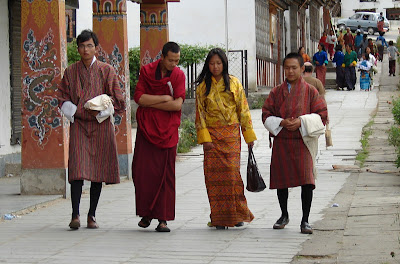Without any particular order or priority, I just start listing a few interesting Bhutanese 'specialities' that I have discovered since I got here. Doing this, I also rely on other sites and not all the photos are mine.
The traditional dress
First thing you would notice in the streets of Bhutan is the colorful national dress: gho for men and kira for women. Although many people, especially teenagers, wear jeans, sports shoes, T-shirt, jacket and baseball hats, still you can see equal numbers dressed traditionally. The national dress was introduced during the 17th century to give the Bhutanese a unique identity and it became the required dress in public in the 1980s. I heared that about 10 years ago a local person could get arrested for wearing a pair of trousers in the street instead of the traditonal clothes. Not anymore. Today, the regulations are more relaxed, but still, in an effort to preserve and promote its cultural heritage, all Bhutanese are required to wear the national dress in government offices, schools, monasteries and on formal occasions.
Nowadays it is fairly common to see people mixing traditional with modern clothes, especially covering the dress with a fake The North Face jacket on a colder day.
If you want to bring a useful gift to a Bhutanese man, get him a pair of pyjamas. No, not the one you would wear during the night! Here, they are called pyjamas, but they are, in fact, long polypropylene thermal underwears that come very handy during wintertime to keep one's legs warm. I wonder about the market for 'pyjamas' in Scotland...
 |
| Two friends 'on the gho' |
 |
| This is not my photo, but a good illustration of local dresses. |
Suja, the salted butter tea
Drinking tea with butter is common in Tibet and Bhutan. This 'energy drink' is called suja in Bhutan and made by churning or stirring salted black tea and yak - or most of the time cow - butter. It is strange to drink it for the first time as your mind expects a tea or coffee and your mouth gets a soup. As a guest, you are always served a cup of suja and you quickly learn to appreciate it. I had my best suja at the home of my colleague, Dorji Tashi, made by his sister with a little bit of ginger in it. Delicious !
Doma, the betel nut
Doma drives me nuts. Doma spots are everywhere, blood-looking stains on people's mouth are common. It is forbidden to chew doma in the cinema, but it is, I feel, chewed everywhere else. Areca nut is commonly referred to as "betel nut" as it is often chewed wrapped in betel leaves with lime. The effect of chewing betel and the nut is relatively mild and could be compared to drinking a cup of coffee. When I tried a bit of areca nut without the 'garnish' I felt dizzy and uncomfortable. Yesterday in the countryside, I asked a man to take me back to Thimphu and he apologized for the smell of his doma. He said he didn't feel any special effect and he used doma as a chewing gum.
| Areca nut |
In the region, there was also a custom to chew areca nut and betel leaf among lovers because of its breath-freshening and relaxant properties. Hence there was a sexual symbolism attached to the chewing of the nut and the leaf. The areca nut represented the male and the betel leaf the female principle.
 |
| Selling doma in Thimphu |
Regularly chewing doma causes the lips and tongue to be stained red, an ancient equivalent of modern lipstick. Some find a woman's lips coloured by red doma sexy, but I have to say I don't.
Some of the liquid in the mouth is usually disposed of by spitting, producing bright red spots all over Thimphu. When I first saw them I thought it was blood...
By the way, doma doesn't just color your mouth, but also likely increases the chances of mouth cancer. Hence, new generations are no longer dedicated fans of doma.
| This is not my photo but you can see the doma effect. |
TO BE CONTINUED...






Very nicely written. The doma effect is applaudable. :)
ReplyDelete